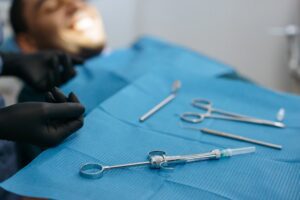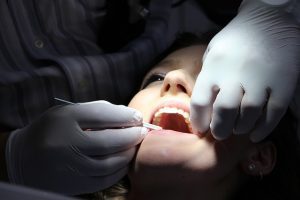Do you feel self-conscious about your uneven smile? If so, you’re not alone. Millions of people are born with an uneven smile, and it can be a source of insecurity for some. After all, first impressions are a big deal; if you’re not happy with how you look, you might not be putting your best foot forward.
Fortunately, there are ways to fix an uneven smile. Whether you’ve got crooked teeth, a misaligned bite, jaw deformation, or facial trauma, there are options to get you that straight smile you deserve.
So, what are the causes of an uneven-looking smile? And what are some methods an oral surgeon might use to adjust and/or reconstruct an out-of-alignment bite? Let’s discuss:
What Causes a Crooked Smile?
An uneven smile can be attributed to multiple factors, both serious and simple. The more simple causes of a smile that looks crooked include:
- Crooked or misaligned teeth
- Missing teeth
- Uneven gum lines
These can be caused by genetics or lifestyle factors. Some of us are born without a couple adult teeth. Some of our teeth may naturally come in crooked. On the other hand, crooked teeth could be due to jaw deterioration from smoking, or uneven gums may appear due to gingivitis. Regardless, these require the least-invasive corrective interventions.
More complicated issues that may be endemic or caused by facial trauma include:
- Over or underbite
- Asymmetrical jaw
- Cleft lip and/or palate
- Wisdom teeth complications
- Broken/compromised jaw
Although these issues may cause your smile to appear uneven due to underlying causes, they typically do not physically cause a crooked smile to occur. Sometimes, illness or illness-related injury can cause a crooked smile due to weakness or malfunction in the muscles and nerves of the face. Some of these include:
- Stroke-induced facial paralysis
- Bell’s palsy
- TMJ
- Trauma-induced facial paralysis
- Guillain-Barre syndrome
- MS
Whether through destruction of bone, soft tissue, muscle or nerve malfunction, these conditions can cause facial weakness that results in a more severe uneven smile.
How do I Fix My Smile?
When it comes to fixing a smile that is uneven, the severity and cause should be evaluated first. Misaligned teeth can be fixed with braces or Invisalign, and uneven gum lines can be helped by surgically reshaping the gum tissue. Missing teeth may be replaced with bridges or implants. These are minimally-invasive oral surgeries that can make a huge difference in appearance.
When attempting to fix a crooked smile that is attributed to a more serious issue, a number of different approaches may be implemented. Often, more complicated causes of an uneven smile require a maxillofacial surgeon who may collaborate with other specialists like ENS doctors and plastic surgeons.
Here are 6 common solutions to a smile that needs realigned:
- Mouth Exercises
A zero-surgery-needed solution, working out some of your key facial muscles can change the appearance of your smile. These exercises help to tone and strengthen facial muscles in order to give the look of a more even smile.
Sometimes referred to as facial yoga, these mouth-centered workouts often involve making a lot of funny faces. Exercises such as these are utilized in physical therapy, as well as occupational therapy settings as well. Mouth exercises can be a useful correction method for crooked smiles caused by:
- Muscle atrophy that results from the recovery period for a broken jaw bone
- Partial facial paralysis caused by an event like a stroke or seizure
- TMJ-induced asymmetry
- Botox
Botox injections might be used to lessen the appearance of a crooked smile, because it can help relax seized muscles. Botox injections essentially paralyze the injection site, which lessens the pull of the muscles that cause the uneven look. This is a minimally-invasive way to correct a crooked smile, and might be a viable treatment option for issues like:
- Irregular jaw muscle development from TMJ
- Uneven gums (via lip injections to alter appearance of gum exposure
- Inconsistently-worn teeth caused by chronic clenching and grinding
- Dental Implants
Dental implants are artificial teeth that are implanted into your jawbone via surgery. They are more permanent than dentures, and can be used to replace a singular tooth or all teeth. Because they replace the entirety of the tooth – including the root – they are a permanent and comprehensive way of replacing troubled or missing teeth. This type of dental intervention can fix crooked smiles caused by things like:
- Genetic abnormalities
- Facial trauma
- Illness-induced tooth loss
If you want to permanently alter the appearance of your teeth further than braces or Invisalign could, prosthetic implants may be the option for you. To learn more about dental implants and how Wilmington Oral Surgery can use them to bring your smile back to life, check out our information page all about them.
- Orthodontia
Orthodontia is one solution to an uneven smile that requires long-term, often progressive, treatment. For things like adult teeth that came in crooked, spacers, braces, mouth guards, and retainers can gradually bring your teeth back into alignment. However, orthodontia can also help with more complicated causes of a crooked mouth, such as:
- Congenital abnormalities like orofacial clefts or jaw bone malformation
- Misaligned jaw, either endemic or injury-induced
- A crowded mouth
- Corrective Jaw Surgery
If the unevenness in your smile is caused by a structural issue within your face, treatment will likely include cooperation between different maxillofacial specialists, including those ENTs and plastic surgeons. Besides reconstruction for facial trauma and/or bone loss, a few types of corrective surgeries for structurally-uneven smiles are:
- Orthognathic surgery: surgical repositioning of the lower and/or upper jaws to correct a severe misalignment
- Genioplasty: reshaping the chin to correct the appearance of facial asymmetry
- Distraction osteogenesis: gradually lengthening an underdeveloped jaw with a surgically-installed device
- Bone grafting: to supplement missing/inadequate jaw bone caused by orofacial deformities or injury
- Full Mouth Reconstruction
Significant bone, tissue, and jaw loss can result from extreme facial trauma or chronic illness. When the degeneration becomes this problematic, a specialized surgeon should be consulted in order to decide next steps.
Full mouth reconstruction can be done to treat the intricate structures around the mouth and jaw which, in turn, can fix an uneven smile. With our full mouth reconstructive services, Wilmington’s experienced team can help recover the function, appearance and health of your mouth and jaw.
If you’re unhappy with your smile, know that you have options to help fix the problem. You can start by trying some simple at-home mouth exercises or speaking to a dentist about Botox or implants. In more serious cases, you may need an interdisciplinary and longer-term approach to your oral restoration. No matter what, there is a treatment option available to help improve the appearance of your smile and boost your confidence; the right oral surgeon can get you to that beautiful smile you’ve always wanted.










